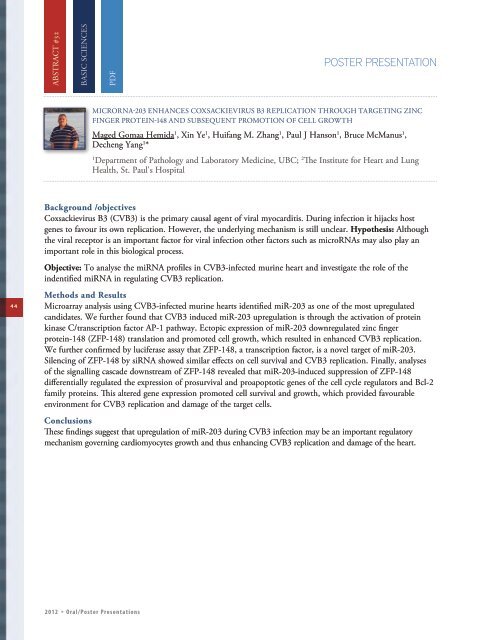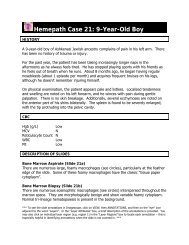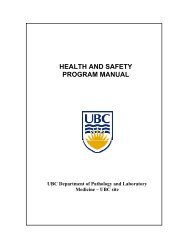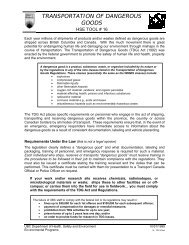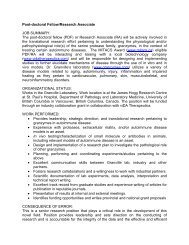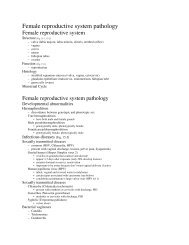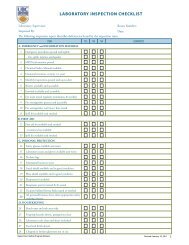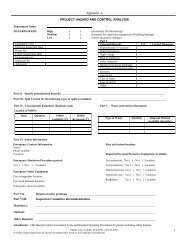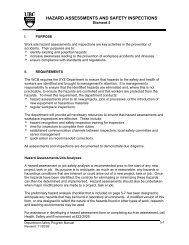Abstract Book - Pathology and Laboratory Medicine - University of ...
Abstract Book - Pathology and Laboratory Medicine - University of ...
Abstract Book - Pathology and Laboratory Medicine - University of ...
Create successful ePaper yourself
Turn your PDF publications into a flip-book with our unique Google optimized e-Paper software.
ABSTRACT #32BASIC SCIENCESPDFPOSTER presentationMicroRNA-203 enhances coxsackievirus B3 replication through targeting zincfinger protein-148 <strong>and</strong> subsequent promotion <strong>of</strong> cell growthMaged Gomaa Hemida 1 , Xin Ye 1 , Huifang M. Zhang 1 , Paul J Hanson 1 , Bruce McManus 1 ,Decheng Yang 1 *1Department <strong>of</strong> <strong>Pathology</strong> <strong>and</strong> <strong>Laboratory</strong> <strong>Medicine</strong>, UBC; 2 The Institute for Heart <strong>and</strong> LungHealth, St. Paul's HospitalBackground /objectivesCoxsackievirus B3 (CVB3) is the primary causal agent <strong>of</strong> viral myocarditis. During infection it hijacks hostgenes to favour its own replication. However, the underlying mechanism is still unclear. Hypothesis: Althoughthe viral receptor is an important factor for viral infection other factors such as microRNAs may also play animportant role in this biological process.Objective: To analyse the miRNA pr<strong>of</strong>iles in CVB3-infected murine heart <strong>and</strong> investigate the role <strong>of</strong> theindentified miRNA in regulating CVB3 replication.44Methods <strong>and</strong> ResultsMicroarray analysis using CVB3-infected murine hearts identified miR-203 as one <strong>of</strong> the most upregulatedc<strong>and</strong>idates. We further found that CVB3 induced miR-203 upregulation is through the activation <strong>of</strong> proteinkinase C/transcription factor AP-1 pathway. Ectopic expression <strong>of</strong> miR-203 downregulated zinc fingerprotein-148 (ZFP-148) translation <strong>and</strong> promoted cell growth, which resulted in enhanced CVB3 replication.We further confirmed by luciferase assay that ZFP-148, a transcription factor, is a novel target <strong>of</strong> miR-203.Silencing <strong>of</strong> ZFP-148 by siRNA showed similar effects on cell survival <strong>and</strong> CVB3 replication. Finally, analyses<strong>of</strong> the signalling cascade downstream <strong>of</strong> ZFP-148 revealed that miR-203-induced suppression <strong>of</strong> ZFP-148differentially regulated the expression <strong>of</strong> prosurvival <strong>and</strong> proapoptotic genes <strong>of</strong> the cell cycle regulators <strong>and</strong> Bcl-2family proteins. This altered gene expression promoted cell survival <strong>and</strong> growth, which provided favourableenvironment for CVB3 replication <strong>and</strong> damage <strong>of</strong> the target cells.ConclusionsThese findings suggest that upregulation <strong>of</strong> miR-203 during CVB3 infection may be an important regulatorymechanism governing cardiomyocytes growth <strong>and</strong> thus enhancing CVB3 replication <strong>and</strong> damage <strong>of</strong> the heart.2012 * Oral/Poster Presentations


